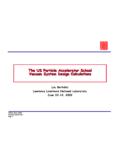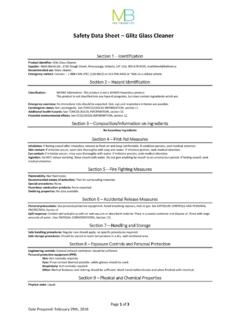Transcription of Non-licensed tasks What this sheet covers
1 health and safety executive Using a Class H vacuum em4 cleaner for asbestos asbestos essentials Equipment and method sheet Non-licensed tasks What this sheet covers This information will help This sheet describes the Class H vacuum cleaner , how to use it to employers and the self- minimise asbestos fibres released during a task, and how to use it employed to comply with to clean contaminated items. the Control of Asbestos Regulations 2012. The cleaner must comply with British Standards. It is also useful for trade union A Class H vacuum is not mandatory for Non-licensed work but can and employee safety representatives. be a useful piece of equipment on a number of tasks . Only carry out work if you are Never use domestic vacuum cleaners, even those fitted with high- properly trained and have the efficiency particle arrestor (HEPA) filters as these are not adequate right equipment. for use with asbestos, and will allow asbestos fibres to pass straight through.
2 Remember: Asbestos fibres can cause fatal lung disease and lung cancer. Check that the vacuum cleaner is in good working order before you start. Read sheet a0. Read the safety checklist. You must be trained to work safely with asbestos materials. vacuum clean carefully. It is easy to disturb asbestos fibres, make them airborne and breathe them in Equipment You can hire or purchase a Class H vacuum cleaner with a range of attachments: look up asbestos safety equipment hire' on the internet. Ensure hired cleaners are clean and in good working order on receipt. The hire company should thoroughly examine and test the cleaner at least once every six months and provide a valid certificate. If the certificate is not in date do not accept the vacuum . 1 of 3 pages em4 Using a Class H vacuum cleaner for asbestos health and safety executive If the certificate is due to expire during the hire period, contact the Caution hire company before expiry to arrange for the equipment to be You, and other people, will re-tested or for delivery of a replacement vacuum .
3 Be exposed to high levels Some Class H vacuum cleaners are designed for wet and dry of asbestos fibres if you fail removal. Select this type of vacuum if water has to be removed. to take the proper Normal Class H dry vacuums can be used for removal of moist or precautions. wetted material but not water. Domestic vacuum cleaners If you own the equipment you will need to arrange for a new should never be used on examination and test on expiry of the certificate. Contact the asbestos. manufacturer or supplier, or a licensed maintenance company, to arrange this or to obtain more information. Vacuuming procedures Inspect the vacuum before each use to check it is in good working order, provides adequate suction and has not been damaged. If fitted with a low-flow indicator, check if this is activated. Follow the manufacturer's operating procedures. Pick up bigger pieces of debris and put them in a suitable waste bag. vacuum clean with care; it is easy to disturb asbestos fibres, make them airborne and breathe them in.
4 Normal Class H dry vacuums can be used for removal of moist or wetted material, but not water. Clean floors, carpets and fabrics with the adjustable floor attachment. Class H vacuum cleaner Clean areas of limited access with the tapered attachment. Clean solid surfaces such as desk tops with the flat attachment. Check for damage after use. British Standards You should only hire a Used as a control measure dust extraction Class H vacuum cleaner that conforms to the You can use the Class H vacuum cleaner to control asbestos following standards. fibres at source, eg: shadow vacuuming: hold the nozzle close to the task (eg screw BS 8520-3:2009 Equipment used in the controlled removal);. removal of asbestos- local dust extraction at the cutting point: enclose the tool containing materials. Gives (eg drill bit) with a drill cowl and attach the nozzle. recommendations for the operation, cleaning and maintenance of Class H. (high-hazard) vacuum cleaners containing a filter conforming to BS EN 1822.
5 In the controlled removal of asbestos-containing materials (ACMs). It does not apply to any other types of vacuum cleaner for vacuuming up liquids or other applications. Control measures: shadow vacuuming and using a drill cowl as local extraction 2 of 3 pages em4 Using a Class H vacuum cleaner for asbestos health and safety executive Possible problems Reduced suction: You have a long extension cable, resulting in low supply voltage. The waste container is full. The hose is blocked. Clearing it can release asbestos; clear it carefully or get help from the hire company. Emptying and cleaning Never clean inside the vacuum cleaner yourself. Never attempt to remove or change the bag yourself; this should be done by a competent person under controlled conditions. Contact the supplier or a licensed organisation for assistance. After each use, clean the vacuum cleaner 's outer casing and attachments with the vacuum and then with damp rags.
6 Rags must be disposed of as asbestos waste (see em9). Inspect the case, hose and attachments visually. Keep the hose and attachments in a labelled plastic sack. Replace the sealing cap over the hose opening in the cleaner 's casing. Store in a suitable sealed container until next usage. Return vacuum to hire company in a double asbestos bag (usually provided by the hire company). There are many makes of Class H vacuum cleaner . Purchase or hire one from a supply company and follow all the instructions (make sure it conforms to BS 8520-3:2009 and contains a filter conforming to BS EN 1822). For information about health and safety , or to report inconsistencies or inaccuracies in this guidance, visit You can view HSE guidance online and order priced publications from the website. HSE priced publications are also available from bookshops. This guidance is issued by the health and safety executive . Following the guidance is not compulsory, unless specifically stated, and you are free to take other action.
7 But if you do follow the guidance you will normally be doing enough to comply with the law. health and safety inspectors seek to secure compliance with the law and may refer to this guidance. This document is available at: Crown copyright If you wish to reuse this information visit for details. First published as part of Asbestos essentials task manual 2001. Published by the health and safety executive 09/17 3 of 3 pages

















